
For every Dan Armstrong product there was an owners manual, a magazine article, a newspaper clipping, even various
drawings or writings. So many products were designed by Dan throughout his career that it's often difficult to know
where to begin. As such I have decided to start at the beginning and proceed as his products did.

|
An early and partial Ampeg ad showing an earlier business address.
|
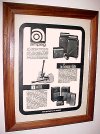
|
As can be read in the guitar section, the Dan Armstrong · Ampeg clear acrylic instrument story
all began with a line of acoustical guitars made by the Grammer Guitar Co. which, along with Ampeg was
owned by Unimusic Inc. With Grammer guitars under the Ampeg tent, Ampeg management visited Dan in his shop to see if
he could improve the quality of these guitars. Dan suggested they forget acoustic guitars and instead focus on building
electric guitars for their amplifiers. The rest was history as they eventually contracted Dan to build a new line of
electric guitars for them. Here is a poster showing the Grammer guitars along with Ampeg amps and Altec Lansing PA systems.
|
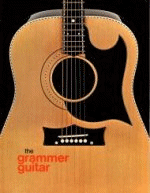
|
A brochure showing Grammer's offerings. The back of the literature is a plug for Dan Armstrong Superstrings. Courtesy of Bill Richardson.
|
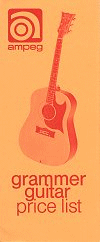
|
A 1969 Grammer guitar price list, dated June 30th of that year. Like the catalogue above this pricing literature lists not
only the various Grammer guitars and cases, but the full line of Dan Armstrong Superstrings, including those for acoustic and electric
guitars as well as bass instruments. The guitar strings ranged in prices from $3.00 to $4.50 while the bass strings were all listed at $15.00.
This and other literature goes to show the in-roads that Dan had going on with Ampeg at the time.
|

|
A very early publication depicts a prototype guitar that was fairly different than what was to be eventually mass
produced. This 1969 brochure shows that a fair number of changes took place. Although minor, such changes are apparent
to those of us who have taken the time to study these instruments. To begin with, there appears to be a different
shaped truss rod cover on the headstock and the truss rod cover only features two screws to secure it to the headstock
whereas actual production models have a somewhat different shape to them and use three screws to secure it to the
headstock.
The prototype pickup was made using a white colored resin which wouldn't harden properly and the shape of the pickup
itself is different as it appears to be wider and thinner than what was produced. Furthermore, there was no sliding
pickup design, or channel routed into the body.
|
Although the brochure does mention interchangeable pickups, it also mentions that one had to loosen the strings, and
snap out the current pickup, then snap in the desired pickup, then re-tighten the strings and finally, bring the
instrument back up to pitch.
Also different is a thin strip of the scratchplate which can be seen lying between the pickup and the combination
bridge/tailpiece. On the scratchplate, near the output jack, there appears to be no selector switch for the tonal
quality of the pickups as Dan did not plan for one being the guitar only housed one pickup at a given time. The
volume & tone potentiometers are trimmed with different looking knobs which are adorned with the Ampeg logo on them.
On the bottom of the lucite body, there is only one guitar strap pin shown. While this is normal for most guitars, the
Dan Armstrong guitars employed two such strap pins on the bottom. The string saddle appears to be made out of metal
(perhaps brass) in the brochure, but by the time they were in production, this had changed to wood, specifically,
rosewood. The bridge/tailpiece combination shown only utilizes three screws that attach it to the lucite body,
whereas the production models had 4 such screws.
Lastly, the lower cut-away of the lucite body is seen identical to the upper cut-away. By production time this had
been re-designed and re-shaped to accomodate for comfort for players who wanted to reach the very top frets. But
overall the literature served to give a curious public a brief look at what Dan was designing, and what was 'cookin'
at Ampeg.
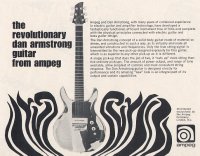
Later that year the same prototype image and wordings could be read in many musical magazines.
|
|
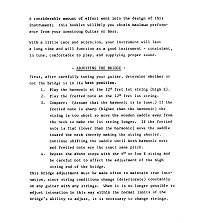
The following user manual accompanied the purchase of a Dan Armstrong · Ampeg guitar or bass.
|
|
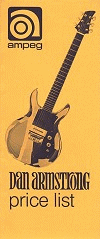
|
Then came this 1969 price list brochure showing the price of a Dan Armstrong ARMG-1 guitar or ARMB-1 bass, effective
on June 30th of that year. Not surprisingly, the price literature still shows a photo of what is now deemed
a prototype guitar. Ironically a bass instrument is not shown in the literature.
Both the guitar and the bass models had a suggested retail selling price of
$290.00 plus another $60.00 for a hardshell carrying case. While this may seem inexpensive in todays world, it must be
remembered that this is in 1969 dollars where minimum wage was somewhere around $2.00 an hour. Still, the price was not
was not out of reach, and many musicians were soon playing one.
|
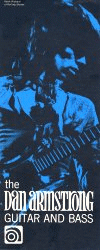
|
In late 1969 Ampeg released this brochure depicting the Dan Armstrong · Ampeg clear guitar and
bass. Featuring Keith Richards of the Rolling Stones on the cover, it goes on to reveal the properties of these two
instruments. Notice on the last page how the wording 'See Through' is trademarked. Courtesy of Bill Richardson.
|
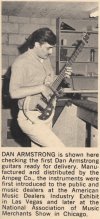
|
A Billboard magazine trade article from 1969 showing Dan Armstrong personally looking over a Dan Armstrong · Ampeg clear
bass prior to shipping. This was a condition that he insisted upon before he would agree to design and build these instruments with Ampeg. Here he looks
to be checking the intonation as his fingers appear to be playing octave G notes up on the neck.
Despite a strained relationship with Ampeg management over amplifiers he continued to show up and inspect the instruments until he
parted company with them in 1971.
Notice the pickup-plate over the pickup as well as the lack of a switch on the scratchplate and Schaller
tuners on the headstock, all consistent with the earliest basses made in 1969. Also notice behind Dan's shadow what
appears to be the letter 'A' on a cardboard box that most likely has the word Ampeg on it.
|
continue
menu
Names and images are TMand © Dan Armstrong / Ampeg. All rights reserved.
All other names and images are TMand © of their respective owners. All rights reserved.
|
| |

